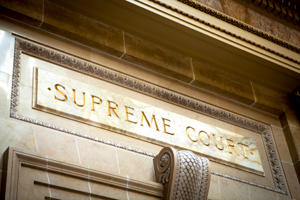 Jan. 30, 2013 – Twelve years after his conviction for armed robbery, Brian Avery argued that a digitally-enhanced video of the crime showed he was too tall to be the robber. But the Wisconsin Supreme Court recently ruled that Avery won’t get a new trial.
Jan. 30, 2013 – Twelve years after his conviction for armed robbery, Brian Avery argued that a digitally-enhanced video of the crime showed he was too tall to be the robber. But the Wisconsin Supreme Court recently ruled that Avery won’t get a new trial.
A state appeals court had ordered a new trial based on “newly discovered evidence” from digital imaging technology that was not available at the time of Avery’s trial in 1995. The new technology improved the quality of the video, which previously showed a “grainy” picture.
Avery’s expert witness, a certified metrologist (the science of measurement) said the enhanced video showed the perpetrator was several inches shorter than Avery, who is serving a 30-year sentence. The state’s expert undermined the accuracy of that assertion, but did not rule it out.
How the Court Ruled
Majority: Crooks, Gableman, Prosser, Roggensack, Ziegler.
Concurrence: Prosser.
Dissent: Abrahamson C.J., Bradley.
In State v. Avery, 2013 WI 13 (Jan. 30, 2013), a state supreme court majority (5-2) reversed the appeals court, concluding that Avery’s new evidence was not compelling enough for a new trial.
“We conclude that there is not a reasonable probability that a jury, looking at both the evidence presented at trial and the new photogrammetry evidence, would have a reasonable doubt as to Avery’s guilt,” Justice Annette Ziegler wrote for the majority of justices.
Newly Discovered Evidence
Avery cleared the initial burden of obtaining a new trial based on newly discovered evidence, which includes proving that the new evidence was not discovered until after conviction.
But a circuit court must also determine that there’s a “reasonable probability” that a new jury would reach a different result, based on the new and old evidence presented at trial.
A circuit court ruled that Avery failed to make this showing, and the supreme court majority ruled that the circuit court did not make this discretionary decision in error.
“[W]e cannot say that the circuit court erroneously exercised its discretion when it concluded that the photogrammetry evidence would not create a reasonable doubt in the minds of the jury,” Justice Ziegler wrote. “Not all new evidence or new technology warrants a new trial.”
The majority noted sufficient evidence to convict Avery, including a confession, an apology note, and testimony from eye witnesses. The jury also heard Avery’s alibi defense and the argument that his confession was coerced, but still convicted him, the majority explained.
It also noted that photogrammetry evidence is not an exact science, and the circuit court was free to conclude that a jury would not find it compelling enough.
“The circuit court correctly balanced the photogrammetry evidence against the evidence at trial,” wrote Justice Ziegler, agreeing with the assessment that the new evidence would not create a reasonable probability that a new jury would have reasonable doubt about his guilt.
Interest of Justice
Avery also argued that he should receive a new trial “in the interests of justice.” But the supreme court majority ruled that a new trial was not warranted on these grounds.
“Avery is not entitled to a new trial in the interests of justice because the controversy was fully tried even though the jury did not hear the photogrammetry evidence,” wrote Justice Ziegler, noting that Avery’s new evidence was not pivotal in forming the foundation of the state’s case.
New trials in the interests of justice are granted only in “exceptional cases,” the supreme court majority explained, ruling that Avery’s case was not an exceptional one.
It noted that in other cases, the newly discovered evidence greatly compromised the state’s case. By contrast, the state did not rely on video identification evidence to convict Avery.
Dissenting Justices
Justice Ann Walsh Bradley wrote a dissent, joined by Chief Justice Shirley Abrahamson, arguing that the majority improperly disregarded the decision of the lower appeals court.
“The standard of review in this case requires us to determine whether the court of appeals erroneously exercised its discretion because it committed a legal or factual error,” Justice Bradley wrote. “[T]he court of appeals has committed no error of fact or law.”
The dissenters said the court of appeals properly exercised its discretion when it determined that Avery should get a new trial in the interests of justice. “[T]he error here lies in the majority’s substitution of its own evaluation of this case in place of the court of appeals’ reasoned determination that this care warrants a new trial,” Bradley wrote.
Concurrence
Justice David Prosser concurred with the majority but wrote separately to express concern about “an important issue of statutory construction affecting postconviction review.”
He urged the court not to approve the application of discretionary reversal powers under Wis. Stat. sections 751.06 (supreme court) and 752.35 (court of appeals) to postconviction motions under 974.06, for fear that it would “seriously jeopardize the high standards of finality.”
“[I]t is not logical to believe that the discretionary reversal statutes give appellate courts power to reverse circuit courts in appeals from Wis. Stat. § 974.06 proceedings,” he wrote.
Attorneys and Amicus Briefs
Assistant Attorney General Thomas Balistreri represented the state. Keith Findley and Tricia Bushnell of the U.W. Law School’s Wisconsin Innocence Project represented Brian Avery.
Amicus briefs were filed on behalf of the Wisconsin Association of Criminal Defense Lawyers, the Innocence Network in San Francisco, and numerous professors and representatives at academic and other law and science institutions across the U.S. and the world.
